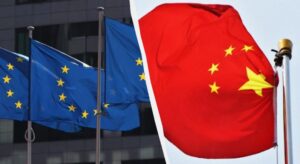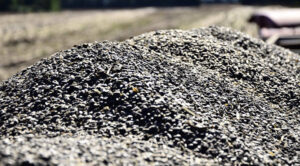
Rush LLC, the owner of EVA network in Ukraine, will allocate UAH 133.8 mln from net profit for the second quarter of 2024 for dividends.
According to the company’s message in the information disclosure system of the National Commission for Securities and Stock Market (NCSSM), a single participant of the LLC made the relevant decision on September 27.
Thus, the distribution of 35% of net profit received in the second quarter of 2024, which amounts to UAH 133.8 mln, was approved for dividends. Accrual of dividends will be carried out no later than six months from the date of the decision.
Earlier, in July, the company allocated UAH 148.8 mln from the net profit for the first quarter of this year for dividend payment.
Rush LLC, which manages the EVA network, was founded in 2002. As of June 31, 2024, the chain had 1,080 operating stores.
According to Opendatabot, the owner of Rush LLC is Cyprus-based Incetera Holdings Limited (100%), with Ruslan Shostak and Valeriy Kiptyk as the ultimate beneficiaries.
According to the results of 2023, the company’s revenue increased by 33.7% to UAH 21 billion compared to 2022, net profit – by 26% to UAH 2.2 billion, the value of assets – by 45.2% to UAH 15.03 billion. In 2023, EVA paid UAH 2.02 bln of taxes and fees to budgets of all levels.

European paint manufacturers are pushing for a review of the European Union’s anti-dumping measures against Chinese exports of titanium dioxide, a key raw material for the industry, saying that they will lead to the closure of plants and further destruction of the region’s industrial base, the Financial Times reports.
Following an anti-dumping investigation launched last year, the European Union imposed temporary duties that could be adjusted or confirmed in January 2025. Paint companies fear that duties of up to 39.7% on titanium dioxide from China will bankrupt small producers and force large ones to move plants outside the EU.
“It’s a question of the survival of the industry,” believes Nicolas Dujardin, chief operating officer of family-owned French paint manufacturer Oceinde. – “If all these anti-dumping investigations lead to such high taxes in Europe, there will be a number of bankruptcies.
The paint and coatings sector will face a prolonged downturn if consumers are hit by higher prices, says Paula Salastie, owner of Finnish company Teknos. If Chinese supplies are diverted elsewhere, a shortage of raw materials will lead to disruptions in production, she says.
“If we can’t sell as much as we planned, we will need to cut jobs,” she said, adding that if duties are imposed, the company will probably look at options for investments outside the EU.
Paint makers believe the duties would be acceptable if introduced gradually along with increased subsidies for local titanium dioxide production.
China’s titanium dioxide capacity has grown from 1.4 million tons in 2008 to a projected 6.1 million tons this year. As a result, China’s share of the global market has risen to 83% from 29%, according to industry information provider TZMI.
Meanwhile, outside China, about 1.1 million tons of capacity was closed during the period, including five plants in the EU, according to estimates by the European TiO2 Coalition, which filed a complaint that led to the launch of an anti-dumping investigation. Paint producers expect the duties imposed in the EU to benefit the UK and also strengthen Turkish competitors, as both countries will still be able to access cheap Chinese raw materials.

The electronic catalog Prozorro Market allowed the state to purchase goods and services worth more than UAH 30 billion in 2024 and at the same time save almost UAH 3 billion, First Vice Prime Minister and Minister of Economy Yulia Svyrydenko said.
“Since the launch of the tool (Prozorro Market – IF-U), the total amount of procurement has amounted to UAH 42 billion. The savings since the beginning of the instrument’s existence amounted to more than UAH 6 billion. This figure is explained by twice as much competition as compared to other procurement procedures. (…) Big savings are an opportunity for the state to buy more necessary goods. And this is especially important for me as the Minister of Economy: Prozorro Market is also a tool for active participation of Ukrainian producers in public procurement. For example, we were able to purchase more than 800 domestically produced school buses through this tool,” the press service of the Ministry of Economy quoted her as saying.
According to Dmytro Solovy, Deputy Director of Professional Procurement for Development, Prozorro Market is expecting a number of key innovations in the near future, including the introduction of a single electronic document that will combine ready-made contracts and terms of reference based on the constructor principle; expanding the range of complaints against unscrupulous suppliers; simplifying the process of qualifying suppliers; and speeding up the bidding procedure by half – from announcement to contract in three days.
“With the outbreak of full-scale war, Prozorro Market has become a tool that allows us to maintain a balance between transparency and competition on the one hand, and efficiency on the other. The e-catalog now effectively covers the needs of both civilians and the military. More than 90% of all food procured at the state level goes through Prozorro Market. The area of military goods is also developing very actively. Our goal is to make it as easy and transparent to buy a drone as a potato. And we are succeeding – 25 thousand different UAVs have been purchased by customers in the e-catalog in two years. In addition, through Prozorro Market, the military can buy tactical headphones, glasses, remote controls for drones, optical sights, night vision devices, etc.”, said Yevhen Yakubovsky, Director of Professional Procurement.
As part of the national forum “Prozorro Market: win-win for the state and business”, its direct customers – public procuring entities and businesses – shared their experience of using Prozorro Market. These include Fabrika-Kuhnya (Bucha, Kyiv region), Ukrnafta, the National Cancer Institute, the state-owned enterprise Forests of Ukraine, Zhytomyr City Council, etc.
The Ministry of Economy clarified that the further development of Prozorro Market is supported by a new 5-year project called Support for Digital Transformation, funded by USAID and UK Dev. They confirmed further support for the improvement of Prozorro Market and the implementation of best procurement practices within the project.

IMC Agro Holding has completed sunflower harvesting on 24.3 thou hectares, yielding 77.7 thou tons of gross harvest with a yield 60% higher than the national average of 3.2 t/ha, the company’s press service reported on its Facebook page.
According to the report, IMC also sowed winter wheat on an area of 20.7 thousand hectares.
“This year, September was abnormally dry and hot, so we managed to complete all field work in a short time. As a result, despite the hot and dry summer, we harvested a good sunflower crop with high quality indicators. As for the winter crops sown at the optimum time, we expect productive precipitation to sprout,” said Bogdan Krivitsky, Chief Operating Officer of the agricultural holding.
“IMC is an integrated group of companies operating in Sumy, Poltava and Chernihiv regions (north and center of Ukraine) in the crop production, elevators and warehouses segments. The company’s land bank is about 120 thousand hectares and storage capacity is 554 thousand tons, with a harvest of 1.002 million tons in 2023.
In the first half of 2023, IMC earned $6.28 million in net profit, down 44.6% year-on-year, while its revenue increased by 61.6% to $71.95 million, including a 41.2% increase in exports to $58.9 million. Normalized EBITDA amounted to $17.06 million, down 41% compared to the first half of 2022, due to higher selling costs and lower harvest prices.

Sukha Balka mine (Kryvyi Rih, Dnipropetrovska oblast), part of Aleksandr Yaroslavskyi’s DCH group, intends to mine iron ore from the Druzhba deposit below the 1,210-meter horizon.
According to the documentation available to Interfax-Ukraine, the planned activity is to open and mine the rich ore reserves of the Druzhba deposit below the 1210-meter horizon at the horizon marks of the mine’s 1227, 1244, 1261 and 1275.
It was clarified that the reconstruction is being carried out to maintain the company’s capacity.
Sukha Balka Mine is one of the leading mining companies in Ukraine. It produces iron ore by underground mining. It includes Yubileynaya and Frunze mines.
In May 2017, DCH Group acquired a stake from Evraz Group.

NNEGC Energoatom has connected a 1000 MW nuclear power unit to the Ukrainian power grid 12 days ahead of schedule, the company said.
“On October 1, after scheduled preventive maintenance, Energoatom specialists successfully connected a power unit of one of the nuclear power plants to the grid. The power is being ramped up. Thanks to the high-quality work of nuclear engineers, the unit was brought out of repair 12 days ahead of schedule,” the company said in a telegram on Tuesday.
It added that after the unit reaches full capacity, the power system will have plus 1000 MW of capacity.
“The repair campaign is entering the home stretch and by the start of the outage, all nine units located in the government-controlled territory will be ready to operate during the most difficult months. I thank the team for their excellent work in difficult conditions,” Energoatom CEO Petro Kotin said in a statement, emphasizing that the work is being performed efficiently and ahead of schedule.
As reported, after the occupation of the 6 GW Zaporizhzhya NPP on March 4, 2022, nine units at the South Ukrainian, Khmelnytsky and Rivne NPPs with a total installed capacity of about 7.8 GW have been operating in the Ukrainian power system.